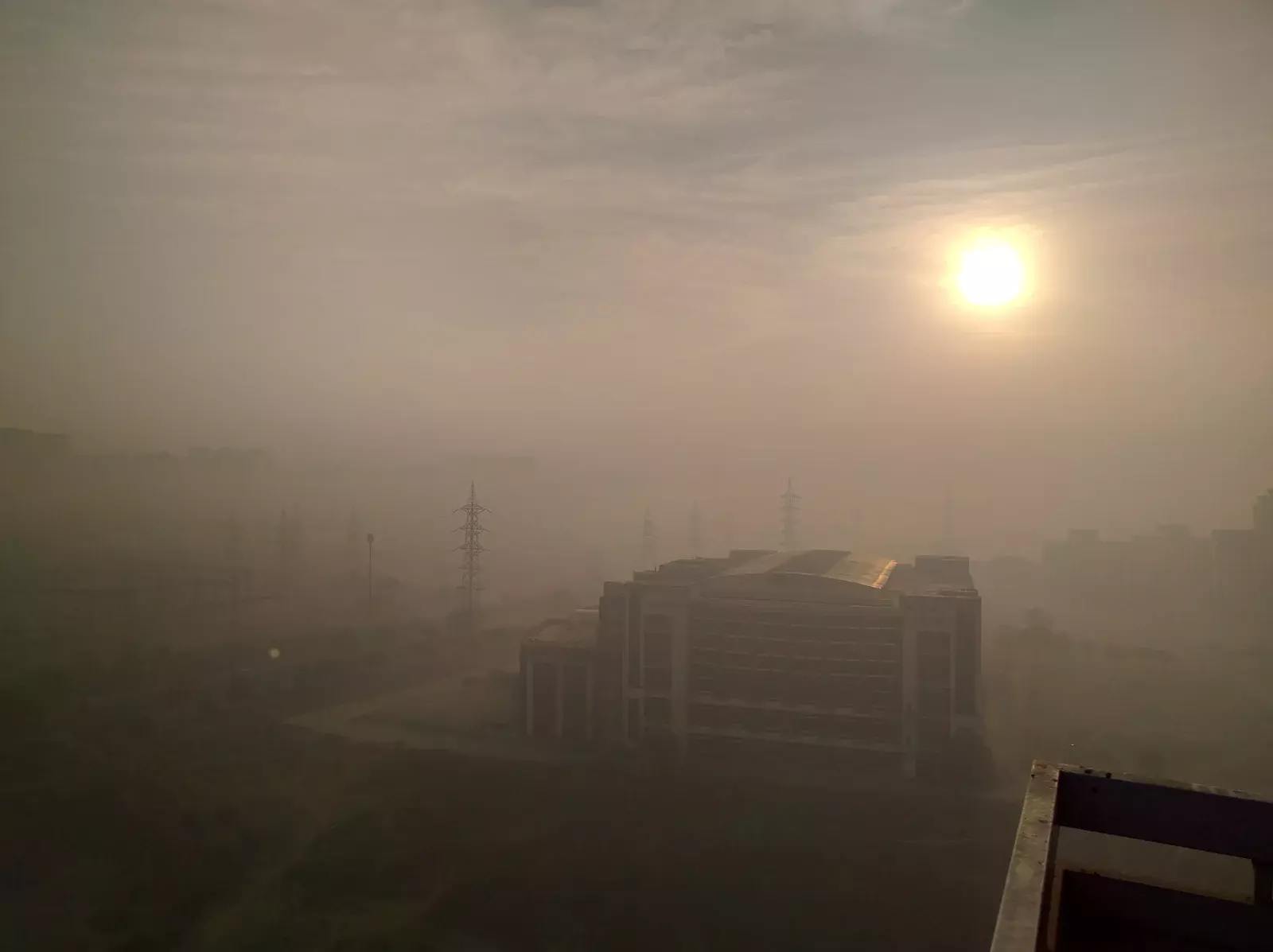North India can expect a prolonged spell of air pollution in the coming months with the appearance of La Niña along with other factors like wind speed, stubble burning and bursting of firecrackers. Weather experts have also warned of extreme cold from December till February next year.
More number of colder days likely in the season due to the La Niña will invariably lead to more number of ‘poor’ to ‘severe’ air quality days ahead for the entire Indo-Gangetic plains, especially Delhi-NCR, warn meteorologists. Wintertime is already conducive for pollution and further drop in mercury would worsen the situation, experts warn.
During La Niña events, trade winds are even stronger than usual, pushing more warm water toward Asia. While Northern India, especially Delhi, witnessed cleaner air due to prolonged monsoon this year and lower number of crop residue burning, the situation is already changing for the Indo-Gangetic plains, which is notorious for severe winter pollution.
The air quality in Delhi-NCR has already hit the ‘severe’ category. As of today on November 6, the air quality index of Delhi fell in the ‘severe’ category and was recorded at 463 in Anand Vihar by CPCB. As per the Central Pollution Control Board (CPCB), an air quality index between 401 and 500 is considered ‘severe’ and affects healthy people and seriously impacts those with existing diseases.
Also Read: Severe peak in winter smog expected in Delhi, quick action required to counter this: CSE Report
With a drop in the temperature, and other meteorological factors such as wind speed slowing down, wind direction, haze setting in – pollution levels are again in the ‘very poor’ and hazardous categories in most cities in North India.
Winter is the favourable time for increase in pollution, as per a brief note by Global Strategic Communications Council (GSCC), a global network of communications professionals in the field of climate and energy. In the wintertime, cold air frequently settles over northern India and wintertime temperature inversions contribute to the build up of haze.
The paper pointed out that chilly days could trap the plains in vicious smog circles that could lead to persistence of consecutive days of bad air quality.
“Intense winters would aggravate the situation. It would mean more amount of haze which would lead to increased trapping of pollutants available over the surface. This might lead to formation of smog which would worsen the condition. All these conditions would result in a vicious smog circle, wherein we would not see clearance for days,” S.N. Tripathi, Head of the civil engineering department at Indian Institute of Technology Kanpur, was quoted as saying.
“Also more cold weather is associated with relatively high humidity, which increases the possibility of particulate matter holding more water. After the fog disappears, water vapour or droplets evaporate leaving the particulate matter behind,” Tripathi added.
The La Niña phenomena
Meteorologists have forecasted record low temperature across Indo-Gangetic plains this year, with November and December expected to be colder than usual. One of the primary factors behind the extreme cold weather is La Niña.
“The oceanic phenomena is expected to peak during this period. Although there is no rule book, with El Niño-Southern Oscillation (ENSO) getting colder than earlier estimates, the confidence in this forecast has grown off late. But, it should be noted that the winter forecast is affected by many other factors from other parts of the globe as well,” G P Sharma, President Meteorology and Climate Change, Skymet Weather was quoted as saying.
ENSO is a recurring climate pattern involving changes in the temperature of waters in the central and eastern tropical Pacific ocean. In a period of three to seven years, the surface waters across a large swath of the tropical pacific ocean warm or cool by one to three degree celsius as compared to normal.
This oscillating warming and cooling pattern, directly affects rainfall distribution in the tropics and can have a strong influence on weather.
“With drop in temperatures, there is potential for more stagnant conditions. However, this is assuming that winds do not change. If winds slow due to any reason and stubble or biomass burning increases during this period, the overall air quality situation may worsen in the Northern Plains including New Delhi,” V Vinoj, Assistant Professor, School of Earth Ocean and Climate Sciences, Indian Institute of Technology Bhubaneswar, was quoted as saying.
Extra caution needed, reducing emissions is the solution
According to the briefing paper of the Global Strategic Communications Council, the focus should remain on curtailing local emissions.
Explaining the importance of reducing emissions especially at the regional levels, Sagnik Dey, Associate Professor at Centre for Atmospheric Sciences, IIT Delhi, said, “If we continue with the same amount of emissions along with unfavourable meteorological conditions, there could be some substantial increase in the pollution levels in the coming season.”
Adding how low temperature can intensify pollution, Dey said, “December and January are the core winter months and we do not expect stubble burning during that time. With record low temperatures likely, we are not left with any other option but to reduce emissions. Otherwise all clubbed together would multiply the impact and pollution would intensify manifolds.”
Stubble burning and air pollution in Delhi-NCR
Delhi witnessed cleaner air in the beginning of the winter season due to on and off rains during October that pushed the peak season of stubble burning.
The total crop residue burning events recorded in 2021, between September 15 to November 1, are 54.8 per cent less than in the same period in 2020, as per the data provided by Indian Agricultural Research Institute (ICAR).
Similarly, average fire counts data, provided by National Aeronautics and Space Administration, in Punjab, Haryana and Uttar Pradesh for the months of September and October in the past five years indicate that the average PM 2.5 levels in Delhi were the highest in 2017 when the average fire counts were the highest too.
Also Read : Stubble Trouble: Air quality dips in Delhi; spotlight shifts to farmers in Punjab and Haryana
Biomass burning has started picking up pace now. Data suggests that Haryana has already surpassed the cases registered last year, followed by Uttar Pradesh which is catching up with the 2020 figure. Punjab is also likely to follow the trend soon, the briefing paper highlighted. Experts are expecting the next two weeks to be crucial for Delhi’s air quality as stubble burning is likely to peak across Indo-Gangetic plains.
Changing weather patterns on account of climate change are also major contributors of air pollution this season. This year, the monsoon had an extended stay and started retreating on October 6 – 20 days after the normal date of commencement of the withdrawal of monsoon. The delayed monsoon pushed the stubble burning season as well as polluted days ahead to November.
“Had the peak of stubble burning been witnessed in October, the impact would have been less over Delhi-NCR. Neither the wind speed would have been slow nor the temperatures were so down. However, November is a changeover month from spring to winters, wherein we would see drop in temperatures as well as wind speed. This coupled with early arrival of winters seems to set up a stage for unhealthy air quality days for the national capital,” Mahesh Palawat, Vice President of Meteorology and Climate Change at Skymet Weather was quoted as saying.
Government guidelines flouted, Delhi’s AQI skyrockets post-Diwali
Delhi Pollution Control Committee on September 15 had issued a complete ban on the sale and bursting of firecrackers in the national capital till January 1, 2022 . This included a complete ban on all types of firecrackers, including green crackers. Delhi’s neighbouring state, Haryana had also imposed a ban on the sale or use of all kinds of firecrackers in 14 districts in the National Capital Region (NCR) and imposed restrictions in other parts.
However, despite the ban hazardous category of PM 2.5 was observed on Diwali night, November 4, in Delhi-NCR. The Delhi Pollution Control Committee and Central Pollution Control Board (CPCB) recorded the range of PM 2.5 from about 8,00-1,700 microgram per cubic metre during 8pm – 5am on November 4. Until 10 am of November 5, PM 2.5 was still very high and reached 400-500 microgram per cubic metre on most of the stations. Stations at places like Dwarka, Jahangirpuri, RK Puram, Nehra Stadium, and Anand Vihar reflected extremely high values of 1,400-1,700 microgram per cubic metre during mid-night. The safe levels of PM 2.5 are 60 microgram per cubic metre, anything beyond that is considered hazardous for the respiratory system.
Also Read: Ahead of Diwali, Delhi’s air quality dips to ‘very poor’ category; likely to remain so till Nov 6
Other gaseous pollutants increased by a factor of 5 to 10 times including that of sulphur dioxide and nitrogen dioxide etc.



















